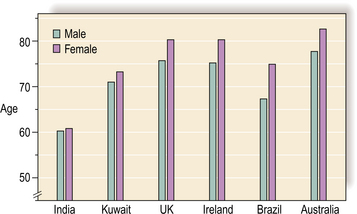Chapter 23 Gender and health
Gender is one of the important divisions in society along with social class and ethnicity. Gender patterns existing within wider society are reflected in medicine. Health services providers need to understand gender differences and their implications for health and health service uptake in order to provide the most appropriate and acceptable care to patients.
Difference in mortality and morbidity
Women live longer than men, even in the least developed countries (Fig. 1). Men are more likely to die compared with women in the same age group, from the day they are born. Table 1 clearly shows differences in Scottish perinatal mortality statistics. The rates indicate that baby boys are more likely to die than girls. This pattern is the same for any other age group in Scotland and for other industrialized countries, and many developing countries.

Fig. 1 Life expectancy at birth by gender for selected countries
(from Department of Economic and Social Affairs, Population Division, 2006, with permission)
Morbidity statistics for Scotland (Table 1) indicate that women are more likely to have had an acute illness in the previous 2 weeks than men. This gender difference is even more profound in the over-75 age group




